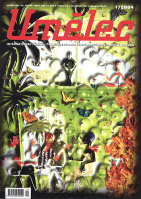| Revista Umělec 2004/1 >> Tereza Damcová | Lista de todas las ediciones | ||||||||||||
|
|||||||||||||
Tereza DamcováRevista Umělec 2004/101.01.2004 Jiří Ptáček | new faces | en cs |
|||||||||||||
|
Tereza Damcová was born in 1977 in Brno. Since 1999 she has been studying at the Faculty of Fine Arts in Brno (the graphics atelier of Margita Titlová — Ylovsky).
The self-portrait videos of Tereza Damcová make ones blood run cold. When in Srdce (Heart), she tears into a plasticine model of what is both the central muscle of the circulatory system and love, we can see how she increases her self-destructive fervor to cast off the “mask of life” as guitar riffs fade. In Pohádka pro malého chlapce (A story for a little boy), she puts on the make-up of a somnambulist geisha, immerses herself into a stream and washes off black and red colors. The clear water rinses away feminine (menstrual?) blood. Tereza Damcová’s ways of expression are through signs and diverse plains of symbolic com- munication. Playing the heroine, she beautifies and defaces herself, frees herself from any stimulus of the nervous system, she sheds tears and twists her face with a pained smile, affectedly falls into egotistical exaltation and then lets the camera sail endlessly through a glittery “landscape” of a large crown that she crafted for the film. Many people are put off by the way Damcová plainly reveals psychic planes of human existence. To depict death, she digs her own grave, surrounds it with candles, lies down inside, and then she documents it. However, in the next production of the video she develops this macabre deed into a ritual of personal obsession. Actually, all of her films draw from dreams. In the process of realization, they form a Gordian knot of meanings fraught with the foreboding of advanced neurosis. The pathos, confusion and stubborn insistence with which she asserts as important the experiences she conveys, can explain the sharp reactions around. Even though we can’t get over the feeling that we are watching some obscure home video, we mustn’t forget that Tereza Damcová is relying increasingly on impeccable camera and editing work, and that she draws us into her trauma and emotional movements intentionally. She attends diligently to the soundtracks of the scenes. For example, in Vánoční disko (Christmas Disco) the music and the action are inseparable. Extortionate world music alternates with rhythmical funk that accompanies a fight between a black and a white hand — a contention of two substances of “something” (Life? Cosmos? Emotions? Everything?). What appears trite in description, but is in fact powerfully imposing on screen. Tereza Dam- cová shows us a willingness to share a dreamily categorized vision of life. To understand how it actually is with the artist, let us recall an earlier performance. Wearing a canary-yellow swimming suit that she made out of cotton wool, Tereza Damcová jumped into the ice-cold water of a fire reservoir. To do that, she first had to carve a hole in the ice; after the performance, she suffered from tonsillitis for a few weeks. The urge to have a radical experience with the body and be purified through that, was stronger than the instinct for self-preservation.
01.01.2004
Artículos recomendados
|
|||||||||||||






















Comentarios
Actualmente no hay comentariosAgregar nuevo comentario